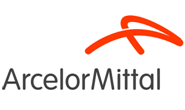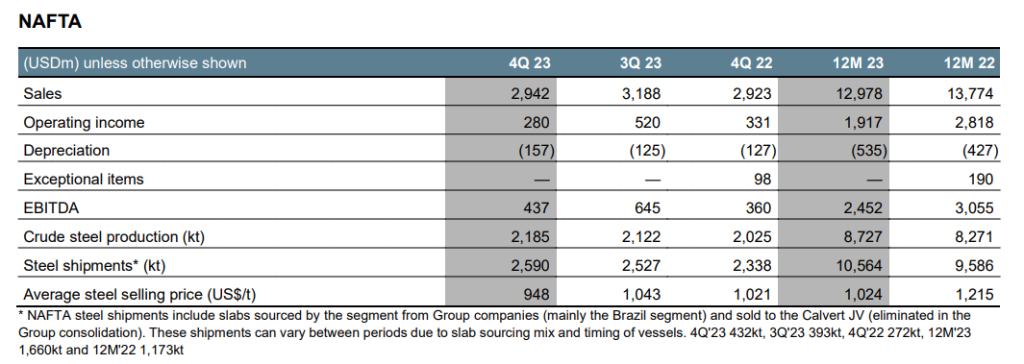Steel Mills

ArcelorMittal posts Q4 loss on mining disaster, sees better demand ahead
Written by Michael Cowden
February 8, 2024
ArcelorMittal
| Fourth quarter ended Dec. 31 | 2023 | 2022 | % Change |
|---|---|---|---|
| Net sales | $14,552 | $16,891 | -14% |
| Net income (loss) | ($2,966) | $261 | -1,236% |
| Per diluted share | ($3.57) | $0.30 | -1,290% |
| Full year ended Dec. 31 | |||
| Net sales | $68,275 | $79,844 | -14% |
| Net income (loss) | $919 | $9,302 | -90% |
| Per diluted share | $1.09 | $10.18 | -89% |
ArcelorMittal swung to a loss in the fourth quarter largely because of costs associated with a deadly coal mining disaster last year in Kazakhstan.
The Luxembourg-based steelmaker sold its Kazakhstan operations in December and no longer owns and operates coal mines as a result of the move, according to comments released along with earnings data on Thursday.
All told, ArcelorMittal recorded a loss of nearly $3 billion in the fourth quarter of 2023 compared to a profit of $261 million in Q4’22.
The loss stemmed not only from Kazakhstan but also from Acciaierie d’Italia (ADI), previously known as Ilva. The Italian government has considered taking a controlling stake in the massive but financially struggling mill, according to media reports.
The company noted that those big losses were one-offs. “Looking ahead, there are early signs of a more constructive industry backdrop,” ArcelorMittal CEO Aditya Mittal said in a statement.
North American results and operations update
ArcelorMittal’s North American operations were a comparative bright spot.

But earnings before interest, taxes, depreciation, and amortization (Ebitda) fell quarter over quarter because of lower steel selling prices that were only partly offset by higher shipments, the company said.
It was a roughly similar story at AM/NS Calvert, ArcelorMittal’s 50-50 joint venture sheet mill in Alabama with Japan’s Nippon Steel:

A quarter-over-quarter Ebitda decline at Calvert resulted from higher maintenance costs and a weaker sales mix. The company said the weaker mix stemmed from fewer shipments to the high-margin automotive market.
On the operations side, ArcelorMittal said it remained on track to start up a new EAF at Calvert – one with annual capacity of 1.65 million short tons (1.5 million metric tons) – in the second half of 2024. And it continues to hold the option to add a second EAF that would sport similar capacity.
Recall that AM/NS Calvert does not currently melt steel but instead relies on slabs brought in from other ArcelorMittal mills or from competitors.
The company said it had also drafted plans to double hot-briquetted iron (HBI) capacity at its plant near Corpus Christi, Texas. Those plans also envision adding carbon capture and sequestration (CCS) capability to the plant.
CCS typically involves capturing carbon emissions and then pumping them deep underground. ArcelorMittal hopes such technology would allow it to produce HBI with an “ultra-low” carbon footprint.
The expansion and upgrades slated for the Texas HBI plant come after ArcelorMittal in 2022 acquired an 80% stake in the facility from Austrian steelmaker Voestalpine for $1 billion.
The big picture
“The company remains positive on the medium/long-term steel demand outlook,” ArcelorMittal said in commentary released with earnings data.
Why? Apparent demand was “showing signs of improvement” across the world as a “destocking phase reaches maturity,” ArcelorMittal said. The company predicted that apparent steel consumption would as a result grow by 3-4% in 2024 compared to 2023.
Turning to the US, ArcelorMittal predicted that demand growth in the US would “remain lackluster” because of the lagging effect of higher interest rates. But a de-stocking cycle in the States, just as in the rest of the world, should end in 2024. That should lead apparent consumption of flat-rolled steel to increase 1.5-3.5% this year compared to last, the company said.
ArcelorMittal expects a “marginal decline” in steel demand in Europe in 2024. Brazil, in contrast, should see a “gradual resumption” in steel consumption. And India should expect “another strong year.”
In China, in contrast, “economic growth is expected to weaken.” But government stimulus and infrastructure spending should help to offset that, the company said.

Michael Cowden
Read more from Michael CowdenLatest in Steel Mills

CRU: Tata Steel looks to shed 1,600 jobs in the Netherlands
The company said, “The challenging demand conditions in Europe driven by geopolitical developments, trade and supply chain disruptions and escalating energy costs have affected the operating costs and financial performance."

Reports: Federal funding for Cliffs’ project could be slashed
Elon Musk's DOGE is determining which Department of Energy grants to advance and which ones to terminate, according to several media outlets

Trump still against selling USS to Japanese firm: Report
Despite ordering a new review of Nippon Steel’s bid for U.S. Steel, President Trump said he is still against selling USS to a Japanese company, according to media reports.

Algoma looks to sell more steel in Canada in wake of Trump’s tariffs
The Canadian steelmaker said its absorbing higher tariffs as it moves forward.

Ancora abandons plan to take over leadership of USS
Investment firm Ancora Holdings Group has halted its play for U.S. Steel's board, citing Nippon Steel’s proposed bid for USS “gaining momentum.”
